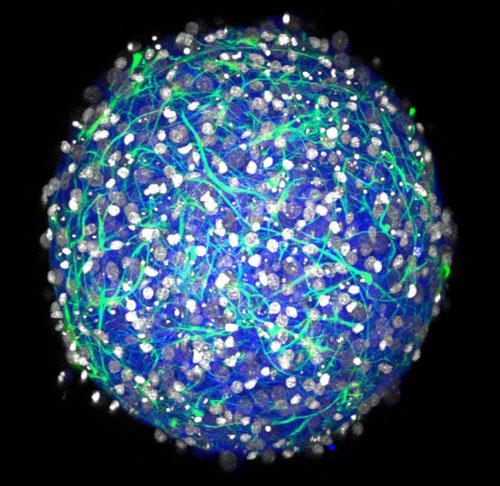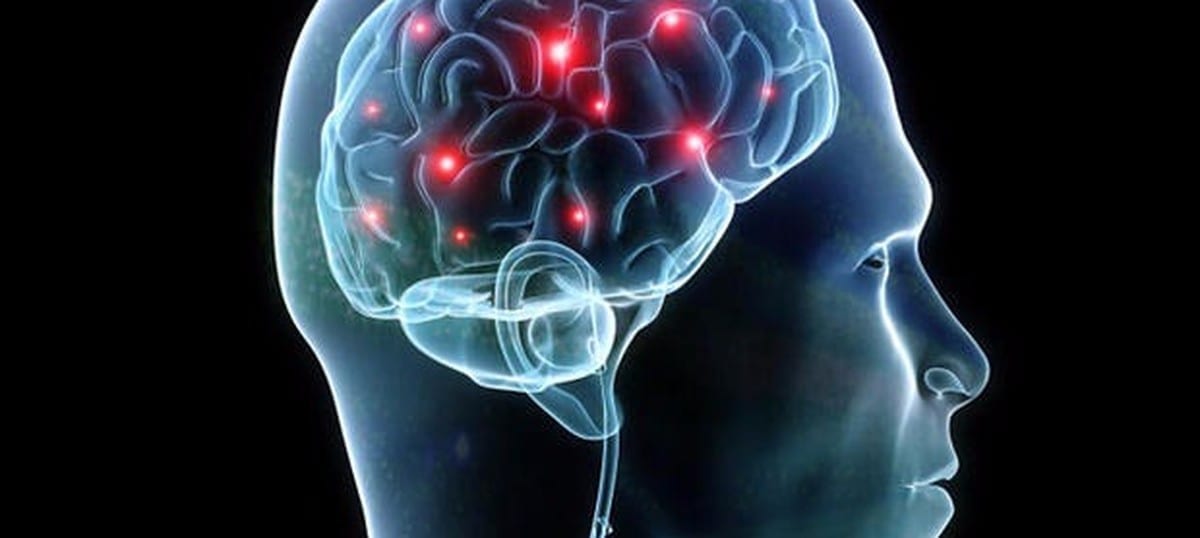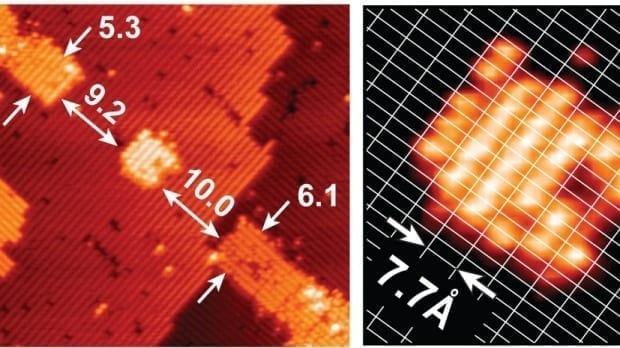
A bioengineering team at Brown University can grow “mini-brains” of neurons and supporting cells that form networks and are electrically active.
Image: Hoffman-Kim lab/Brown University
If you need a working miniature brain — say for drug testing, to test neural tissue transplants, or to experiment with how stem cells work — a new paper describes how to build one with what the Brown University authors say is relative ease and low expense. The little balls of brain aren’t performing any cogitation, but they produce electrical signals and form their own neural connections — synapses — making them readily producible testbeds for neuroscience research, the authors said.
“We think of this as a way to have a better in vitro [lab] model that can maybe reduce animal use,” said graduate student Molly Boutin, co-lead author of the new paper in the journal Tissue Engineering: Part C. “A lot of the work that’s done right now is in two-dimensional culture, but this is an alternative that is much more relevant to the in vivo [living] scenario.”
Just a small sample of living tissue from a single rodent can make thousands of mini-brains, the researchers said. The recipe involves isolating and concentrating the desired cells with some centrifuge steps and using that refined sample to seed the cell culture in medium in an agarose spherical mold.
The mini-brains, about a third of a millimeter in diameter, are not the first or the most sophisticated working cell cultures of a central nervous system, the researchers acknowledged, but they require fewer steps to make and they use more readily available materials.
“The materials are easy to get and the mini-brains are simple to make,” said co-lead author Yu-Ting Dingle, who earned her Ph.D. at Brown in May 2015. She compared them to retail 3-D printers which have proliferated in recent years, bringing that once-rare technology to more of a mass market. “We could allow all kinds of labs to do this research.”
Read more: An accessible approach to making a mini-brain
The Latest on: Mini-brain
[google_news title=”” keyword=”mini-brain” num_posts=”10″ blurb_length=”0″ show_thumb=”left”]
via Google News
The Latest on: Mini-brain
- Tacky but additive: How mini-dramas cash in on millions of viewers' emotional demandson April 26, 2024 at 2:33 am
Wang attributed the breakneck tempo of mini-dramas to the fragmented viewing habits of mobile phone users, who consume content on-the-go. Other than sitting in a cinema to concentrate on the plot, ...
- Woot Deals of the Day: Look Out, 2 Blink Mini 2 Cameras for $50on April 25, 2024 at 5:55 am
If home security cams aren't your thing, we also found the Pixel 7 Pro for nearly half price and the super comfortable Skullcandy Crusher ANC 2 headphones at a steal.
- Our Toyota Tundra TRD Pro Was Shot At by Smooth-Brain Moronson April 24, 2024 at 9:57 am
An attempt at a bro-tastic weekend went awry when we took our Toyota off-roader into the desert looking for fun.
- Mini-colon and brain 'organoids' shed light on cancer and other diseaseson April 23, 2024 at 5:00 pm
When the researchers injected the cancerous cells into mice, the tumours looked similar to those seen in human colorectal cancer. The organoids accumulated fewer tumours when the researchers ...
- New study examines the increased adoption of they/them pronounson April 19, 2024 at 10:30 am
People are using "they/them" pronouns more often according to a new study by the University of North Carolina at Chapel Hill.
- An old barn falls down like a house of cards, and a house is hit with pickleson April 19, 2024 at 3:00 am
A barn suddenly collapses, a house gets hit by pickles, and other odd tales from local police and fire departments.
- Ayaneo Mini PC AM02 review: “I’ve never been this hyped for a low-spec rig”on April 18, 2024 at 4:09 am
The Ayaneo Mini PC AM02 is an incredibly small NES-inspired rig that packs the same punch as a high-end gaming handheld, making it a must-have for small setups.
- Early Warning Signs Of Mini Stroke: What Are The 5 Main Symptoms That You Must Take Note Of?on April 17, 2024 at 11:54 pm
A brain stroke can happen with various intensities. If you are experiencing a mini stroke, you should consider it as a warning for a possible major stroke which may even be fatal.
- Mini brains and lab-on-a-chip wearables: Jumar Bioincubator officially begins its mission to build "Australia's next CSL"on April 17, 2024 at 5:00 pm
Tessara Therapeutics is creating "mini brains" in test tubes through 3D neural micro-tissues that mimic the human brain and offer all the essential requirements for drug discovery, including dense and ...
- Sony might have perfected Mini LED TVs with its new 2024 lineupon April 17, 2024 at 1:01 pm
At the premium end of home theater, Sony TVs are about as good as it gets — and have been for several years now. The company is lauded for its image processing and penchant for delivering fantastic ...
via Bing News










